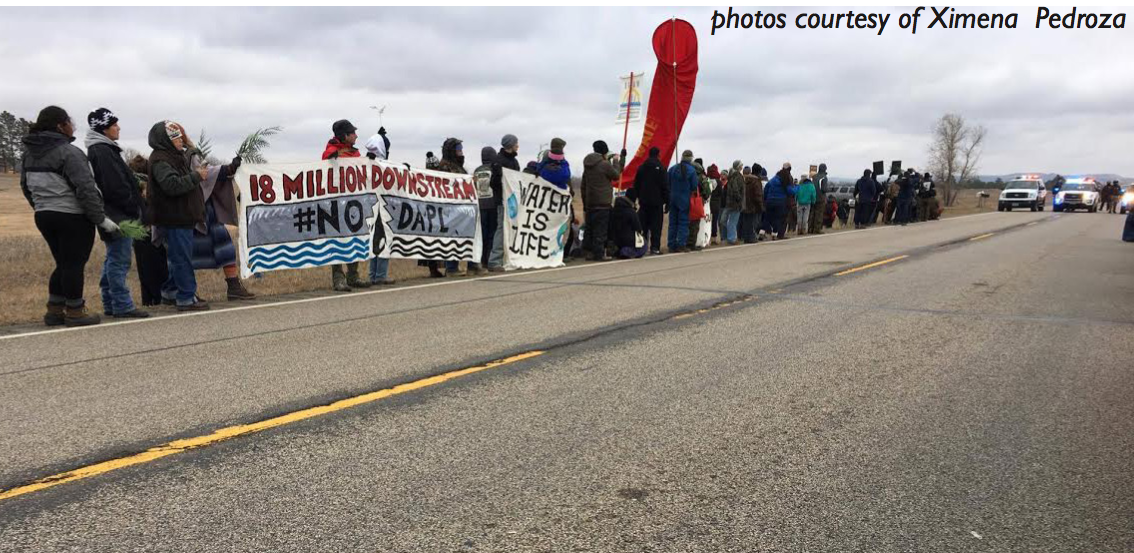
While most Americans were celebrating the Thanksgiving holiday, protesters on the Standing Rock Reservation were fending off tear gas while being sprayed by water cannons in sub-freezing temperatures and shot by rubber bullets and concussion grenades.
On the night of Nov. 20 around 6 p.m., an hours-long confrontation between law enforcement and protesters began when about 100 activists attempted to clear a barricade which blocks the bridge to Bismarck, North Dakota – the nearest large city to the Sacred Stone Camp. The barricade forces emergency service vehicles to make an approximately 20-mile detour to reach those at the camp, considered to be a threat to the safety of those at the camp.
The situation escalated as hundreds of protesters were shot at with water cannons in sub-freezing temperatures, a decision made by the Morton County Sheriff’s Department, which many are calling “unethical”, as well as tear gas, rubber bullets, sound weapons and concussion grenades.
According to Ximena Pedroza, a second-year New College student who was at the Standing Rock camp when the altercation broke out, rubber bullets had their casings removed, exposing a hard plastic interior that seriously injured several people.
“There were multiple women that were shot in the face with these bullets,” Pedroza said. “There are people right now preparing for surgery to ensure they don’t lose their vision.”
Vanessa Dudon is at least one of the water protectors who requires urgent surgery after being shot in the face with a tear gas canister by law enforcement. The impact left Dudon’s face bloodied and swollen, severing the retina in her right eye. Even with surgery, Dudon’s vision will be impaired for the rest of her life.
The Morton County Sheriff’s Department claimed law enforcement were using water cannons because protesters were lighting fires around the bridge.

“People were using fires to keep themselves warm in sub-freezing temperatures and to make hot food to eat,” Pedroza said. “And the sheriff’s department said they used water cannons to put out the fires, yet if you watch the video all you see is them hosing down people who have their hands up in the air, that are nowhere near a fire. […] It’s police brutality.”
The militarization of police forces against peaceful citizens is an image that echoes throughout the nation, conjuring images of officers in SWAT gear against unarmed protesters in Baltimore reacting to the death of Freddie Gray. The Standing Rock Sioux tribe’s fight to secure clean water is a mission shared by Americans still suffering in Flint.
“This is just the recurring pattern of white colonialism,” Pedroza said.
The physicians and tribal healers with the Standing Rock Medic and Healer Council released a statement on social media calling for “the immediate cessation of use of water cannons on people who are outdoors in 28F ambient weather with no means of active rewarming in these conditions. As medical professionals, we are concerned for the real risk of loss of life due to severe hypothermia under these conditions.”
The recent confrontation has caused international outcry about the unethical treatment of “water protectors” those protecting the Missouri river water table from the Dakota Access Pipeline (DAPL), an oil pipeline that is proposed to be built through sacred Native American land which could pollute the water source for millions of people if it spilled.
Over 300 people were injured and 26 taken hospitalized as a result of the “less-than-lethal” weapons used by law enforcement. Among those injured is an elder of the Standing Rock Sioux Tribe who went into cardiac arrest while on the front lines and was revived by medics on scene.
“I saw people covered in bruises from rubber bullets,” Pedroza said. “It’s one thing to read about it, to see it in pictures, than to see the injuries on the bodies of people right in front of you, people who are doing nothing but protecting water, protecting the sacred.”
Sophia Wilanksy, a 21-year-old protester from New York, may lose her arm as a result of the blast of a concussion grenade which has shattered her shoulder. Gruesome photos of her injury which shows exposed broken bone have circulated social media, causing more public outcry. Police deny using any equipment that could have caused her injury.
Dallas Goldtooth, an organizer with the Indigenous Environmental Network, said they were told by law enforcement that if they demonstrated peacefully, the barricade would be taken down.
“As long as protests and marches happen almost daily on the damaged Backwater Bridge it will not open,” wrote Rob Keller, a spokesman for the Morton County Sheriff’s Department in an official statement. “The protesters are the ones not keeping their word.”
The U.S. Army Corps of Engineers has recently issued an eviction notice to those at Standing Rock urging protesters must leave by Dec. 5. The eviction cites “concern for public safety” as a reason to clear the camp, and reads that anyone choosing to stay would be doing so “at their own risk.”
However, water protectors are remaining resolute and intend to impede the DAPL for as long as possible. The construction deadline for the pipeline is Jan. 1, meaning if oil is not flowing by that day, the contract expires and investors will be able to back out of the deal completely.
This deadline gives hope to many supporters of the #NoDAPL movement, which can be seen in the increase of donations to the cause. To find ways to help, go to official website for the Standing Rock Sioux Tribe at standingrock.org.

